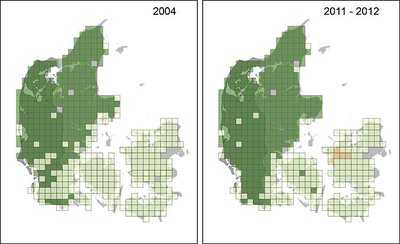Danish otter population continues to grow
The otter has made a unique comeback to Danish nature. In 1980 it was considered one of the most threatened mammals in Denmark.

By Bjarne Søgaard, Morten Elmeros, Liselotte Wesley Andersen, Aksel Bo Madsen, Poul Nygaaard Andersen & Peter Mikkelsen, Department of Bioscience and DCE – Danish Centre for Environment and Energy, Aarhus University
The otter has made a unique comeback to Danish nature. In 1980 it was considered one of the most threatened mammals in Denmark, but recent monitoring undertaken in 2011-2012 shows that the species is now found all over the peninsula of Jutland, from Skagen in the north to the Danish-German border in the south. Moreover, DNA analyses conducted by Aarhus University show that the otter is still found on the island of Zealand and has spread to the island of Funen.
The Topic Centre for Biodiversity and Terrestrial Nature under theDCE – Danish Centre for Environment and Energy, Aarhus University, has together with the Danish Nature Agency carried out nation-wide monitoring in 2011-2012 of the distribution of otters in Denmark within the framework of the Nationwide Monitoring and Assessment Programme for the Aquatic and Terrestrial Environments (NOVANA). Similar nation-wide monitoring was undertaken during 1984-1986, 1991, 1996 and 2004, giving a good possibility for comparing the spread of the otter population over an almost 30-year-long period.
Significant increase in distribution area
The results show that the occurrence of otters has significantly increased since the mid-1980s when otters were almost exclusively found in north-west Jutland. Since 2004 otters has been spotted as far south as to the Danish-German border and the latest survey showed that otter now occur throughout Jutland. DNA analyses of faeces collected on the islands of Funen and Zealand reveal that otters have distributed to these areas as well.

Distribution of otters in squares (10x10 km) as evidenced by the national monitoring surveys in 2004 (including supplementary investigations) and 2011-12. In the dark green squares traces of otters were found, while no traces were found in the light green squares. In the yellow squares traces of otter were discovered in a survey conducted in 2006.
In the nation-wide monitoring surveys no traces were found of otters on the island of Zealand, but genetic analyses of faeces samples collected during an intensive survey organised by the Danish Society for Nature Conservation in 2006 proved these to originate from otter. These results confirm the findings from intensive surveys in Zealand in 1995 and 1996 in the same river systems in western Zealand.
Otters on Funen
DNA analyses of two faecal samples from 2012 collected at River Odense and on the south-eastern coast of Funen show that also these originated from otter. The first indication that otters have now spread to Funen was the finding of a road-killed, young male otter in 2007 in a small stream in the River Odense catchment.
Findings of road-killed young male otters have typically preceded the spread of the species to new areas in Jutland. Thus, the road kill in 2007 was probably the first indication of the reoccupation of Funen by otters. The most recent documented presence of otter on Funen before 2007 was a drowned otter in a fish trap in Odense Fjord in 1979.
The search for otter spraints and footprints includes a nation-wide net consisting of ca. 1,240 stations covering in about 500 squares of 10x10 km. If traces of otters are found at just one station in a square, the square is recorded positive for the species. In this way, the distribution of the species can be compared between the different monitoring years.
Contact: Senior biologist Bjarne Søgaard – Tel.: +45 4025 685, bjs@dmu.dk
DCE – Danish Centre for Environment and Energy
Department of Bioscience, Aarhus University
